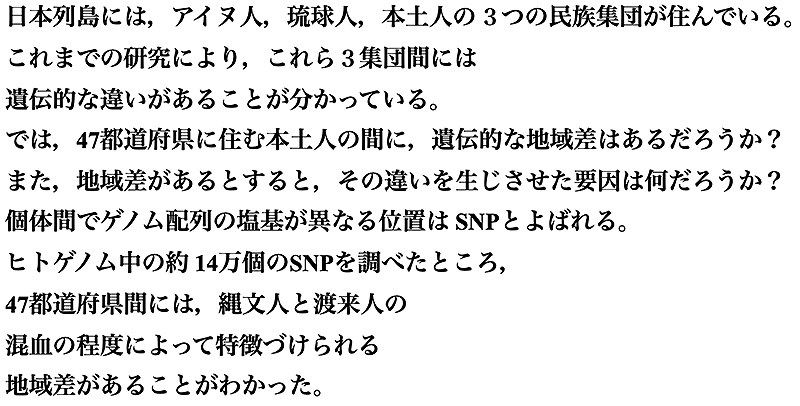Disclaimer: machine translated by DeepL which may contain errors.
Genetic Regional Differences among 47 Prefectures
Jun Ohashi( Associate Professor, Department of Biological Sciences) |
Yusuke Watanabe* (Department of Biological Sciences, 3rd Year Doctoral Student) |
Mariko Isshiki* (3rd Year Doctoral Student, Department of Biological Sciences) |


Humans have inhabited the Japanese archipelago for more than 30,000 years, with the Jomon period beginning about 16,000 years ago. It is believed that about 3,000 years before the Yayoi Period began, the Jomon people, who had been living in Japan until then, interbred with the migrant people from the Asian continent. Recent DNA research has revealed that the descendants of the mixed Jomon and Ryukyuan populations are the mainlanders, and that the Ainu and Ryukyuans were less affected by interbreeding than the mainlanders were. DNA studies have provided much insight into the genetic background of the Japanese population, but the genetic regional differences at the prefectural level have not been well understood.
The positions at which bases in the genome sequence differ among individuals are called SNPs. The fact that alleles of SNPs tend to be more similar among genetically related individuals can be used to evaluate genetic differences among individuals and regions. We analyzed SNP genotype data from approximately 140,000 SNPs in 11, 000 Japanese individuals living in 47 prefectures to determine whether genetic regional differences exist among mainlanders. Principal component analysis, one of the multivariate analysis methods for individual genotype data, confirmed that many people in Okinawa Prefecture are genetically distinct from people in other prefectures. Although only address data were used in this study, and the exact ethnic group to which each individual belongs is not known, this may be due to the large number of Ryukyuans among the residents of Okinawa Prefecture. Next, to examine the genetic relationship among prefectures, a principal component analysis was conducted on the mean allele frequency data calculated by randomly selecting 50 individuals from each prefecture. In terms of the value of the first principal component, Kagoshima Prefecture was closest to Okinawa Prefecture, and Aomori and Iwate Prefectures in the Tohoku Region were also close to Kagoshima Prefecture. On the other hand, prefectures in the Kinki and Shikoku regions were distant. The value of the second principal component was correlated with latitude or longitude. Considering the results of other statistical analyses as well, the first principal component reflects differences in the degree of admixture between the Jomon and continental migrants (the closer to Okinawa Prefecture, the closer to the Jomon), and the second principal component reflects geographical location (prefectures that are close to each other are genetically closer).
 |
||
| Results of principal component analysis for 47 prefectures (left) and distribution of first principal component scores for 46 prefectures excluding Okinawa Prefecture (right). | ||
Including the results of studies that have examined DNA extracted from Jomon bones, it is estimated that the current mainlanders possess about 20% of the genomic components derived from the Jomon people. In other words, about 80% of the genomic component of the mainlanders is derived from the transplanted people. Although most of the migrant people are thought to have arrived in the Japanese archipelago via the Korean Peninsula, a larger proportion may have flowed into the Kinki and Shikoku regions, rather than into northern Kyushu, which is geographically closer to the Korean Peninsula. This study has revealed genetic kinship among the 47 prefectures. However, a major question remains. At the time of intermixture with the migrant population, about 80,000 Jomon people lived in the Japanese archipelago, and their residential area covered the entire Japanese archipelago. Could it be that the sea-going visitors ever predominated? The population history of the Japanese people is of endless interest.
The results of this study have been published in Y. Watanabe*, M. Isshiki* et al . , Journal of Human Genetics (2020) (DOI: 10.1038/s10038-020-00847-0).
* Co-first author. Academic year is at the time of the study.
(Press release, October 14, 2020)
Published in the January 2021 issue of Faculty of Science News
Communicating to Faculty Research Students at the Forefront of Research>


